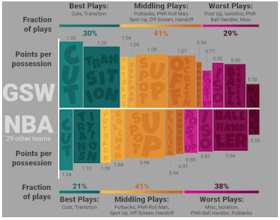Plan your offseason development now.
Priority 1: Build fundamental finishing and shooting. Priority 2: Score more baskets in transition.
Priority 3: Build hard to defend concepts to develop consistent half-court offense.
Extrapolating from NBA basketball to youth basketball is a long slide. What types of higher points/possession plays fit? Reduce the options. Combine spacing and timing with better execution. Use more statistically favored actions.
Cuts
Pick-and-roll
Catch-and-shoot (spot ups)
Off-ball screens
Combinations
Choose Initial formations (e.g. spread, horns). Add scoring actions and practice the fundamentals needed to execute. We want to teach simple actions as well as finishing consistently from either side of the rim.
CUTS
Spread development diagram. Focus on the right half...with give-and-go or wing pass with backcut from corner. After passing, the 1 can screen away for either 4 or 5 or 1 can go "thru" to the corner and 4 and 5 can "fill" up. We can practice this with 6 players without weak side action.
Horns action with backcut from corner. 3 must clear through if not open to create isolation for 5 (especially if she can create off isolation).
Horns pick-and-roll slice. The Tufts women ran this action combining pick-and-roll with a cut from the opposite post player.
OFF BALL SCREENS
It's not rocket science (my wife is a rocket scientist). Young players struggle to defend screens but also to wait for and read screens.
Remember the Purple Cow? Not enough P's. If you have the personnel, then this action with a pindown creates a nightmare with options.
Take advantage of personnel mismatches with simple screens (e.g. a cross-screen). It's not hard to understand why teams zone to mitigate simple actions.
Experience coaches will say, "that's baby stuff." Well, how many high school games do you see where teams don't even run the baby stuff?
Lagniappe: In Flex, you "set a screen, then get a screen." In this video, the baseline cutter gets a screen and then sets a screen.





